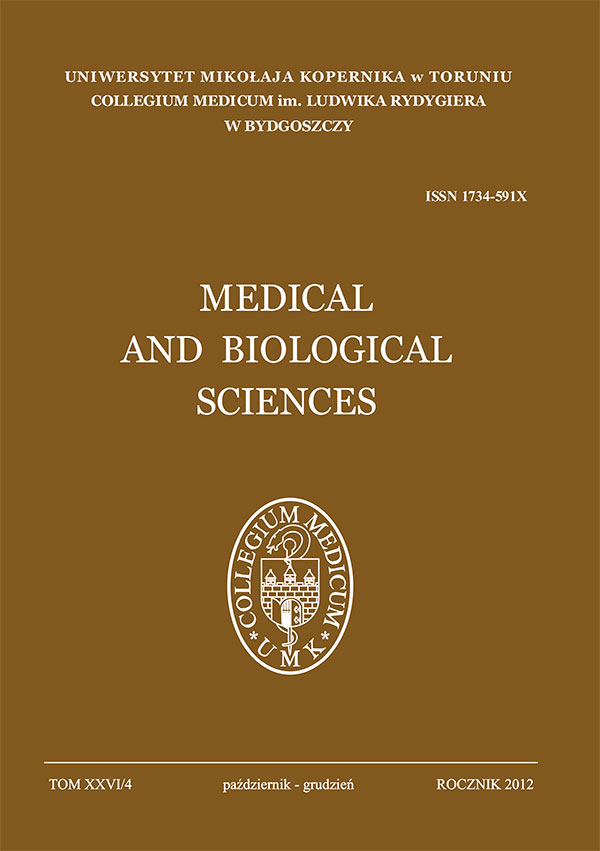Effect of McKenzie method on the severity and location of pain in patients with lumbo-sacral discopathy
DOI:
https://doi.org/10.12775/v10251-012-0072-0Keywords
Mckenzie method, discopathy, painAbstract
Lumbar spine discopathy is a serious social and economical problem in both our country and around the world. The severity of pain significantly impairs the performance of basic activities such as: dressing, walking, sitting, sleeping, traveling, social and sexual life that make up the quality of life.
The aim of the study is to investigate the effect of rehabilitation conducted by McKenzie method on the value and localization of pain ailments.
The study included 45 patients treated for pain ailments accompanying lumbar discopathy, in whom the analogue VAS scale was used to assess pain.
There was no effect of gender, age and number of episodes of pain on the location of the pain. Pain ailments increased during bending (95.6%, N = 43), standing up (88.9%, N = 40) and standing (48.9%, N = 22), and decreased during lying down (77.8%, N = 35) and walking (73.3%, N = 33). McKenzie method treatment significantly influenced the location of the pain, because prior to treatment, patients experienced pain: within the leg and foot (40%, N = 18), thighs (36%, N = 16) and sacrum (24%, N = 11) and after therapy, these proportions were : 0%: 4%: 29% and 67% , respectively experienced no pain. Pain rated on a VAS scale decreased significantly from 6.58 ± 1.6 to 0.76 ± 0.86. Number of patients taking painkillers directly (66.7%, N = 30) and consistently (22.2%, N = 10) after the treatment was limited to only 1 patient receiving medications directly (2.22%, N = 1).
McKenzie therapy significantly reduces the severity of pain ailments associated with lumbar discopathy, and also limits their range.
References
Dziak A. Bolesny krzyż. . Kraków: Medicina Sportiva; 2003.
Analysis of measures of musculoskeletat diseases and injuries. Amer Acad of Ortop Surg. 1998.
Frymoyer JW. The Adult Spine: Principles and Practice. Philadelphia: Lippincott-Raven; 1997.
Parker H, Wood PL, Main CJ. The use of the pain drawing as a screening measure to predict psychological distress in chronic low back pain. Spine. Jan 15 1995;20(2):236-243. [ http://dx.doi.org/10.1097/00007632-199501150-00022]
Bulpitt CJ. Quality of life as an outcome measure. Postgraduate medical journal. Oct 1997;73(864):613-616.
Glinkowski W, Ciszek, B. Wybrane zagadnienia morfologii i właściwości krążków międzykręgowych. Ortopedia Traumatologia Rehabilitacja. 2004;6:141-148.
Muncey H, Giles, F., Harper, B. Standards for physiotherapists working in pain management programmes. The Chartered Society of Physiotherapy. London1998.
Triano JJ, McGregor M, Skogsbergh DR. Use of chiropractic manipulation in lumbar rehabilitation. Journal of rehabilitation research and development. Oct 1997;34(4):394-404.
Cypress BK. Characteristics of physician visits for back symptoms: a national perspective. American journal ofpublic health. Apr 1983;73(4):389-395.
Dziak A. Bóle krzyża. Warszawa: PZWL; 1997.
Frymoyer JW. Back pain and sciatica. The New Englandjournal of medicine. Feb 4 1988;318(5):291-300.
Deursen L, Snijders, C., Patijn, J. Influence of daily life activities on pain in patients with low back pain. J. Ortopedic. Med. 2002;24:74- 76.
Boissonnault W, Fabio RP. Pain profile of patients with low back pain referred to physical therapy. The Journalof orthopaedic and sports physical therapy. Oct 1996;24(4):180-191.
Donelson R, Silva G, Murphy K. Centralization phenomenon. Its usefulness in evaluating and treating referred pain. Spine. Mar 1990;15(3):211-213. [ http://dx.doi.org/10.1097/00007632-199003000-00010]
Polska IM. Kręgosłup lędźwiowy, Poznań.
Karas R, McIntosh G, Hall H, Wilson L, Melles T. The relationship between nonorganic signs and centralization of symptoms in the prediction of return to work for patients with low back pain. Physical therapy. Apr 1997;77(4):354-360; discussion 361-359.
Long AL. The centralization phenomenon. Its usefulness as a predictor or outcome in conservative treatment of chronic law back pain (a pilot study). Spine. Dec 1 1995;20(23):2513-2520; discussion 2521.
Sufka A, Hauger B, Trenary M, et al. Centralization of low back pain and perceived functional outcome. TheJournal of orthopaedic and sports physical therapy. Mar 1998;27(3):205-212.
Werneke M, Hart DL. Centralization phenomenon as a prognostic factor for chronic low back pain and disability. Spine. Apr 1 2001;26(7):758-764; discussion 765.
McKenzie R. The lumbar spine: mechanical diagnosisand therapy. Wellington: Spinal Publications; 1981.
Marcinek W, Szulc, A. Wiktora Degi Ortopedia iRehabilitacja. . Warszawa: PZWL; 2004.
Machado LA, Maher CG, Herbert RD, Clare H, McAuley JH. The effectiveness of the McKenzie method in addition to first-line care for acute low back pain: a randomized controlled trial. BMC medicine. 2010;8:10. [ http://dx.doi.org/10.1186/1741-7015-8-10]
Al-Obaidi SM, Al-Sayegh NA, Ben Nakhi H, Al- Mandeel M. Evaluation of the McKenzie intervention for chronic low back pain by using selected physical and biobehavioral outcome measures. PM & R : the journal ofinjury, function, and rehabilitation. Jul 2011;3(7):637-646; quiz 646.
Fowler B, Oyekoya, O. The therapeutic efficacy of McKenzie Concept in the management of low back pain. Proceedings 12 International Congress WorldConfederation Physical Therapists. Washington, USA1995.
Goldby L. A randomized controlled trial comparing the McKenzie method of mechanical diagnosis and therapy with a non-prescriptive exercise regime in the conservative treatment of chronic low back pain. Proceedings 4 McKenzie Institute InternationalConference. Cambridge, England1995.
Grand G, Gille, K., Degerfeldt, L. McKenzie method and functional training in back pain rehabilitation. A brief review including results from a four-week rehabilitation programme. Physical Therapy Reviews. 2000;5:107-115.
Downloads
Published
How to Cite
Issue
Section
Stats
Number of views and downloads: 413
Number of citations: 0



